#5g architecture
Text
1 note
·
View note
Text
Healthcare Mobile App Development: Key Types, Latest Trends, and Cost Analysis - Technology Org
New Post has been published on https://thedigitalinsider.com/healthcare-mobile-app-development-key-types-latest-trends-and-cost-analysis-technology-org/
Healthcare Mobile App Development: Key Types, Latest Trends, and Cost Analysis - Technology Org
These days, apps have made a lot of healthcare services more accessible. These technologies make our lives easier by offering easy payment alternatives, timely appointment scheduling, and instant access to medical information. Medical personnel and patients may both benefit from the education provided by healthcare mobile applications.
Thus, creating mobile apps for healthcare is a good idea. But to develop a workable solution, you must take into account a few crucial factors.
Image credit: DC Studios via Freepik, free license
Prominent Types of Healthcare Apps
Before you contact the developers of custom medical software or create it yourself, you must have a good understanding of the topic.
Healthcare mobile apps generally fall into several core categories:
Patient Engagement Apps connect users to care teams for appointment scheduling, medication reminders, symptom tracking, medical record access, wellness education, and more. These boost convenience, satisfaction, and care plan involvement.
Telehealth Apps enable video visits, remote consultations, and health assessments replacing some in-clinic services via mobile devices or wearables. Growing reliance on telehealth given convenience and past pandemic necessity will fuel app innovation.
Clinical Reference Apps supply medical professionals with on-demand information access at the point of care via mobile devices instead of manual materials. Detail functionality includes drug databases, EHR integration, diagnostic support aids, and medical calculators.
Remote Monitoring Apps allow care, teams, to continually collect patient health data from IoT devices and at-home testing kits. Real-time monitoring apps catch warning signs early before conditions escalate into emergencies to minimize hospital visits.
Hospital Operations Apps designed for internal hospital/clinic use help manage workflows, asset tracking, staff coordination and shifts, bed management, and HR functions. These drive productivity and oversight.
Health and Wellness Apps encourage consumers to actively manage diets, fitness goals, and overall wellbeing. Integration with wearables and personalized insights helps drive behavioral change and sustain user motivation over time.
Notable Healthcare App Development Trends
Reaching $974.5 billion by 2027, the worldwide healthcare IT market is expected to develop at a compound annual growth rate (CAGR) of 19.8% from 2022 to 2027. This means that this type of application will be in greater demand every year.
As consumers expect seamless service and clinicians demand efficient tools, various forces shape the healthcare app landscape:
Interoperability – The Open API ecosystem allows health apps to securely integrate with diverse medical systems and insurance payers to centralize patient information.
Cybersecurity – Health data represents highly sensitive info requiring robust, proactive safeguards woven into software architecture.
Cloud Adoption – Cloud platforms enable flexible storage, mobility, convenient deployment, and scaling for unpredictable user spikes.
Artificial Intelligence – AI chatbots, predictive algorithms, and diagnostics decision support integrated into apps for automated and personalized experiences.
Blockchain Uses – Blockchain shows early promise in securing medical records sharing between apps and tracing pharmaceutical supply chains.
5G and Edge Computing – Faster 5G networks and decentralized data processing drive real-time clinical capabilities and rapidly evolving app functionality.
Voice Assistants– Voice UIs improve navigation and data entry efficiency during clinical workflows when physicians’ hands are occupied with patients.
Factors Impacting Healthcare App Costs
Because healthcare apps manage critical, highly personal data within a complex regulatory environment, specialized security, compliance, and integrations QA testing add costs not typical for consumer-grade apps. Wide variability exists based on app type, features, custom vs off-the-shelf components, healthcare application development company rates, and projected lifespan.
Smaller patient engagement apps range from $25,000 to $75,000. Robust telehealth apps span $100,000 to $500,000. Highly customized clinical apps integrating AI and real-time data analytics land from $500,000 to over $1 million.
Ongoing costs must be accounted for as well over multi-year lifecycles. These include developer staffing for upgrades and maintenance, changing compliance demands, hosting fees, customer support, and help desk troubleshooting. Annual recurring costs can add 25-30% of the initial price.
Final Words
For healthcare organizations lacking budgets to build full-fledged custom apps outright, taking iterative approaches beginning with basic viable products, and then adding capabilities over multiple release phases spreads investment as user adoption and ROI materialize. Third-party developer partnerships and open-source code reuse also constrain expenses.
Despite substantial investments required, thoughtfully designed healthcare apps driving patient engagement, improving care team coordination, and optimizing clinical and operational decisions will rapidly demonstrate value.
#000#2022#5G#ai#Algorithms#Analysis#Analytics#API#app#app development#application development#applications#appointment scheduling#apps#architecture#artificial#Artificial Intelligence#billion#Blockchain#budgets#change#chatbots#Cloud#code#compliance#computing#consumers#cybersecurity#data#data analytics
0 notes
Text

Vario Exclusive 5G Rio & Sydney Laminat Parke
#Vario Exclusive 5G Rio & SydneyLaminat Parke#bursa vario rio laminat parke#bursa vario parke#bursa vario laminat parke#hotelrenovasyon#evdekorasyon#paradorparke#oteldekorasyon#ofisdekorasyonu#architecture#hoteldekorasyon#insaatproje#mobilyamagazazeminrenovasyon#evzeminparke
0 notes
Text
ba6e2eec-9876-4b66-955e-cb9e5e2446f7
ba6e2eec-9876-4b66-955e-cb9e5e2446f7 https://api.nasa.gov/
https://data.nasa.gov/profile/rosdiablatiff01/qt5r-jgxh
https://www.earthdata.nasa.gov/
https://www.nasa.gov/directorates/heo/scan/worldquantumday
Rosdi Ab Latiff
https://urs.earthdata.nasa.gov/profile
Mobile Technology High Devices
0 notes
Link
1 note
·
View note
Text
putting together a list of some of my favourite reads from 2023:
Ozempic, Barbie, and the failure of corporate feminism
Read This Before You Buy That Sweater
Vladimir Nabokov's Butterflies
Inside the Pages of a Medieval Sketchbook
how come these ghosts is white?
Is 5G Going to Kill Us All?
Mattel, Malibu Stacy, and the Dialectics of the Barbie Polemic
I'm a fake brand, in a fake world: The secrets behind designing a great fictional brand for TV and film
What is Brutalist Architecture?
With 'The Far Side', Gary Larson Pioneered the Art of the Meme
A Star Reporter's Break With Reality
Walt Disney cheated his animators out of profits--and their strike changed the world
When Your Parents Are Dying
Here's Why Movie Dialogue Has Gotten More Difficult To Understand (And Three Ways To Fix It)
A Year Later, I Still Can't Stop Thinking About Disco Elysium
Dune Has a Desert Problem
Time Loop Narratives Are About Love
#personal#not necessarily all published this year but ones i read or revisited this year#and i wanted to keep track in a nicer way than just my tabs lol#reading of 2023#subject to change or be expanded upon as i go thru my history and bookmarks lol
5 notes
·
View notes
Text

Future Air Combat System (FCAS) and the Military Internet of Things
Fernando Valduga By Fernando Valduga 11/22/2023 - 20:35in Military
The FCAS Air Combat Cloud (Air Combat Cloud) will bring real-time intelligence to the forefront, taking advantage of the network capabilities of different aircraft and platforms. Innovations in Artificial Intelligence (AI), big data processing and cybernetics will help make defense a truly collaborative mission.
Europe's Future Air Combat System (FCAS) will see next-generation manned jets flying alongside remotely piloted unmanned aircraft carriers of various sizes. These assets will be part of a fully interconnected "system of systems", based on open architectures, which will allow the integration of other existing platforms, such as the A400M or the A330 MRTT tanker plane. At the heart of this complex system will be the Air Combat Cloud, which will allow these platforms to work together.

But what exactly is an air combat cloud? As FCAS Combat Cloud product solution leader at Airbus, Ignacio Rosell often asks this question.

“How does the Android ecosystem work? We have an operating system that allows the integration of applications from different parts, and all this is supported by a communication infrastructure such as 5G, Bluetooth or Wi-Fi. If we apply this analogy to the FCAS, we are developing an important part of the "Internet of Military Things". Our mobile phones can be a fighter plane, an unmanned aerial system (UAS), a warship, a satellite or even a soldier on the ground, each integrating different applications or, in other words, different capabilities. Our air combat cloud has the same components, the communications infrastructure, the operating system and the applications that allow us to operate collaboratively," adds Rosell.
Launched by France, Germany and Spain, and with Airbus, Dassault Aviation and Indra as national industrial coordinators, the FCAS is one of the most important European defense programs of the coming decades. In a context of growing global instability, the objective of the project is nothing less than to design an air defense system that protects Europe, while strengthening its strategic autonomy and technological sovereignty.
Airbus leads the Combat Cloud pillar, with Thales and Indra as main partners. This is one of the seven areas of next-generation FCAS technology (see the infographic on the side), led at Airbus by Marc Paskowski.
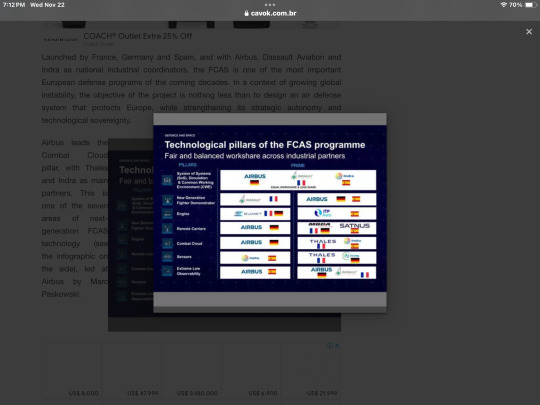
It will provide a common situational awareness, capturing, sharing, merging and instantly processing large amounts of data from all connected manned and unmanned platforms, reliably, and transforming that data into actionable information, taking advantage of constantly evolving learning technologies. "The concept based on the cloud in flight is that all elements must constantly interoperate with each other to form a cohesive system that is informed as one and fights as one," says Paskowski.
"Our 'operating system' will need to be opened to accommodate ready-to-use and tailored applications, such as manned and unmanned teams, from Airbus or any other industrial partner. It will be an evolutionary process, with new applications, such as new aerial platforms, being integrated along the way," says Rosell. "Our business model around the Combat Cloud will not be unique. An area such as satellite connectivity could be offered as a service, while an 'app' part of an aircraft's mission system could be sold as a product,” he adds.
The development of intermediate solutions as part of this "internet of military things" should allow customers to use various levels of cloud capabilities and remote operators long before FCAS became operational in the 2040s. For example, Airbus has already carried out the first successful launch and operation in the world of a Remote Carrier flight test demonstrator from an A400M in flight.
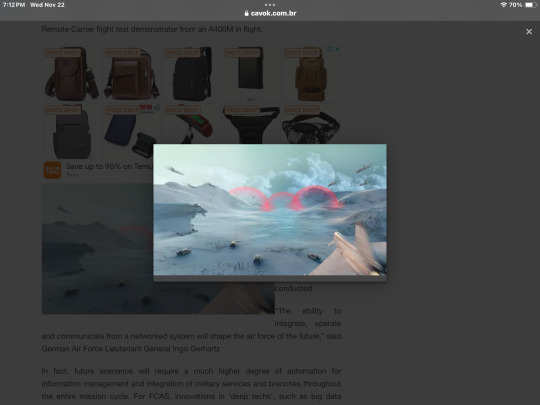
Based on this incremental approach, the air combat cloud will be the digital watershed in the way military operations are conducted.
“The ability to integrate, operate and communicate from a networked system will shape the air force of the future,” said German Air Force Lieutenant General Ingo Gerhartz
In fact, future scenarios will require a much higher degree of automation for information management and integration of military services and branches throughout the entire mission cycle. For FCAS, innovations in 'deep techs', such as big data processing, artificial intelligence and cybernetics, will provide the advanced intelligence of the cloud, allowing, for example, the distribution of Command and Control (C2) functions, including to the pilot in his fighter. and provide key stakeholders in a mission with all relevant information in real time. "This will give Air Force decision makers an unprecedented level of awareness," says Paskowski.
But with great power comes a great responsibility. With the growing dependence on artificial intelligence on everything we do as "digital citizens", and the use of platforms such as ChatGPT and its impact on the workplace, the integration of AI at the heart of FCAS Air Combat Cloud presents new challenges. Questions such as 'to what extent will the system support the decision-making process?' or 'What are the ethical criteria that can be applied to the use of this technology?'

Control or be controlled: that's the question
In order to anchor ethical issues and legal principles in the FCAS project, Airbus and the Fraunhofer Institute came together in 2019 to launch a joint expert committee on the responsible use of technologies. It brings together interested parties from the German Air Force with universities, research institutes and a broad group of foundations, specialists in social sciences and engineering science design.
Based on this guidance, within FCAS Air Combat Cloud, AI will provide analysis of complex situations during multi-domain operations and recommend the most intelligent action in the correct sequence. The human will then validate the recommendations. If the operational pace is high, the human being will simply decide whether or not to veto the recommendations, and the subsequent processes will again be automated by AI. “Our European air defense system will always be under the full control of a responsible human operator and in all circumstances,” concludes Marc Paskowski.
Both technologically and militarily, the development of FCAS has the potential to establish new standards and revolutionize the use of air power.

The use of AI in Airbus
Airbus began integrating AI into its products and solutions in the 1990s, with applications for reading and interpreting satellite images.
OneAtlas imaging services harness the power of Airbus' constellation of optical and radar satellites with reliable AI and cloud technology to provide important information, for example, to combat deforestation, optimize agricultural yields and urban planning.
However, in the aeronautical sector, Airbus' Skywise big data platform collects data from 24,000 aircraft parameters, allowing airlines that subscribe to the service to perform predictive maintenance and improve the overall operational efficiency of their fleets.
Tags: airbusMilitary AviationFCAS - Future Combat Air System/Future Air Combat System
Sharing
tweet
Fernando Valduga
Fernando Valduga
Aviation photographer and pilot since 1992, has participated in several events and air operations, such as Cruzex, AirVenture, Dayton Airshow and FIDAE. He has work published in specialized aviation magazines in Brazil and abroad. Uses Canon equipment during his photographic work in the world of aviation.
Related news
WAR ZONES
AC-130J aircraft attacks militants in Iraq after first ballistic missile attack against U.S. positions
22/11/2023 - 16:00
MILITARY
F-35 fighters will cost Canada almost $54 billion in 45 years
22/11/2023 - 14:19
MILITARY
Indonesian Air Force receives new Dassault Falcon 8X aircraft
22/11/2023 - 14:03
MILITARY
Russian Air Force receives new batch of Su-34 fighter-bombers
22/11/2023 - 10:46
MILITARY
VIDEO: The impressive attack of the Houthis, with a Mi-171, on a cargo ship in the Red Sea
21/11/2023 - 23:09
BRAZIL
VIDEO: FAB celebrates 40 years of the T-27 Tucano aircraft with special paint
21/11/2023 - 19:30
Client PortalClient PortalClient PortalClient PortalClient PortalClient PortalClient PortalClient PortalhomeMain PageEditorialsINFORMATIONeventsCooperateSpecialitiesadvertiseabout
Cavok Brazil - Digital Tchê Web Creation
Commercial
Executive
Helicopters
HISTORY
Military
Brazilian Air Force
Space
Specialities
Cavok Brazil - Digital Tchê Web Creation
4 notes
·
View notes
Text
since 1968-michaelharrelljr.com Domain Creator [D.C.] of harrelltut.com… Electronically Think [E.T.] Computationally like AutoCAD-86 1.30 (7/11/83) Victor 9000 (c) Copyright 1982, 1983, 2023 Autodesk, inc. [A.i.] Serial Number: 06-002009… Eye Intuitively Download [I.D.] quantumharrelltech.com’s Highly Complex [ADVANCED] Ancient 6g-quantumharrell.tech Intelligence of Microchip [I’M] Antennas 4 Wireless Applications of iquantumcad.com's 6g-quantumharrell.tech Computer Aided Three-Dimensional Interactive Application [CATDIA] Software... Electronically Embedded [SEE] in 6g-quantumharrell.tech's Computer Aided Manufacturing [CAM] Hub of the MOON’s Interplanetary [MI - MICHAEL] 6g iCloud Mechatronic [METATRON] Robotics… Mathematically Accessing Computational [MAC] Grid Networks [MGN] @ quantumharrelltelecom.tech’s att.com
WELCOME BACK HOME IMMORTAL [HIM] U.S. MILITARY KING SOLOMON-MICHAEL HARRELL, JR.™

i.b.monk [ibm.com] mode [i’m] tech [IT] steelecartel.com @ quantumharrelltech.ca.gov

eye kingtutdna.com domain creator [d.c.] of harrelltut.com

IGIGI Teleported [IT] 1698 michaelharrelljr.com 2 Earth [Qi] since 1968-michaelharrelljr.com ALUHUM ANUNNAGI 2

ommmmm
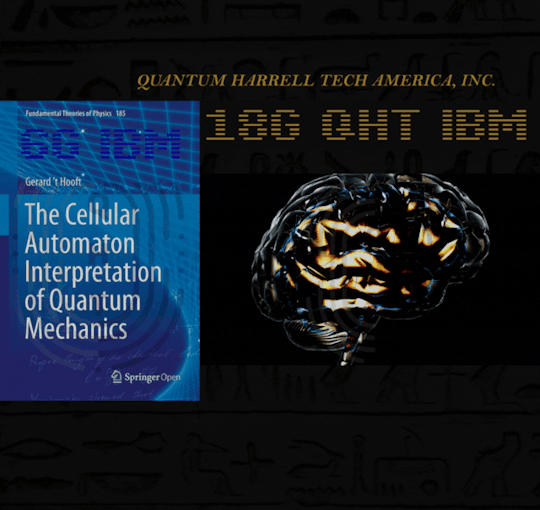
ommmmm

iquantumcad.com of 6g-quantumharrell.tech networks

iquantumcad.com of 6g-quantumharrell.tech networks

6g-quantumharrell.tech's Interplanetary MOON [I'M] Networks?!?!?!

2023 5g slow af... 2024 6g-quantumharrell.tech already in place

quantumharrelltech.com’s domain creator [d.c.] enabling wireless 6g-quantumharrell.tech mobile networks

6G 6G 6G [666] quantumharrell.tech patents @ att.com?!?!?!

6g-quantumharrell.tech's architecturally intelligent [a.i.] robotics [air]... deep inside the quantumharrell.tech moon universe [mu]

hallo qdara.tech pro of quantumdara.com's ancient6-18gmilitary.tech bot workforce @ quantumharrelltech.ca.gov

6g-quantumharrell.tech's architecturally intelligent [a.i.] robotics [air]... built the moon
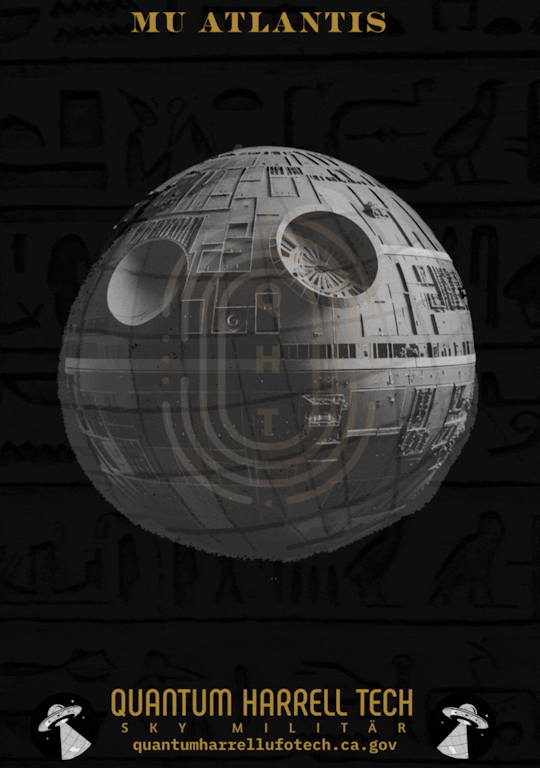
6g-quantumharrell.tech's architecturally intelligent [a.i.] robotics [air]... frontiers of 2024 6g wireless sky systems

eye 1968-michaelharrelljr.com's 6g-quantumharrell.tech communication systems

can u hear 1968-michaelharrelljr.com's 6g-quantumharrell.tech thoughts???... what about now???

eye quantumharrelltech.com's militarized wireless 6g-quantumharrell.tech patents

eye heard about my mother's american telegraph & telecom [at&t] district economy of ancestral [dea] patent communication [pc] laws from 1698att-internetair.com's att.com… since everythingblackwallstreet.tech business secrets @ quantumharrelltech.ca.gov

hallo??? may i [mi = michael] speak 2 michael the 1968quadrillionaire.tech creator of 1698att-internetair.com @ att.com?

eye play [i/p] 2 win at all costs

eye 6g-quantumharrell.tech patents of att.com's 1968att-internetair.tech mechanics
#mu:13#kemet#u.s. michael harrell#harrelltut#att#at&t#at&t tv#michael certified ethical hacker#anu black wall street#METATRON
2 notes
·
View notes
Text
FTTA: High-Performance Solution for Integrated Optical Fiber and 5G Networks
There is a huge demand for high-speed data transfers in today’s mobile telecommunications networks. FTTA (Fiber-to-the-Antenna) is an essential element of 5G networks and ensures reliable, robust, and future-proof installation, improves user experience and reduces costs. This article helps you to understand FTTA.
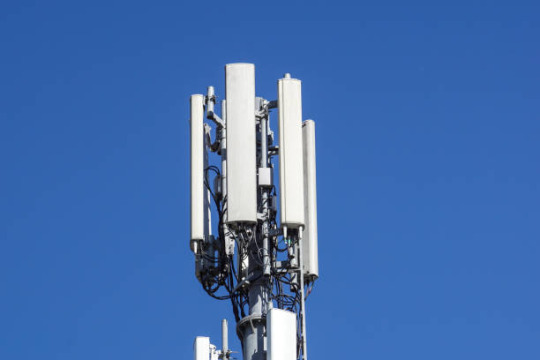
What is FTTA?
FTTA is a broadband network architecture to connect the building baseband unit (BBU) to the remote radio unit (RRU) at the top of the tower by using optical fibers to replace all or part of the coaxial network. FTTA can reduce the loss of signal power. And up to 20km's maximum transmission distance helps realize centralized placement of base stations (BS) in lower-cost telecommunication rooms and more flexible and modularized network planning.
FTTA Solution
FTTA solution reduces installation time and saves the cost of installation and maintenance. FTTA solution includes outdoor optic fibers, PDLC outdoor waterproof patch cords, terminal boxes, etc.

Benefits of FTTA
Perhaps the most benefit of FTTA stems from the physical content of the cable itself. The smaller diameter and lighter weight allow many fiber optic cables to occupy the same amount of space as a single coax cable. Because cellular towers are naturally subject to the elements, the physical size and properties of optical cabling are much less susceptible to damage from gusts of wind.
Other benefits of FTTA relate to the shift from analog to digital. Due to signal losses, the coax cable limited the distance between the antenna and the base station to as low as around 100m. Optical cabling can span up to 20 km with minimal losses.
FTTA provides improved energy consumption and signal integrity. Tower amplifiers are no longer required to combat the inherent noise floor of extended coax runs. The cooling of power amplifiers through air conditioning in a traditional base unit is replaced by ambient air cooling of the RRH, which significantly reduces the electrical power consumption of the system.
FTTA also provides flexible deployment, reduced complexity, saves installation time and space on the tower, lower investment, and high reliability.
Typical FTTA Scenario
Fiber optic networks aim to perform high-speed, error-free data transmission. Adequate testing during each phase of the network deployment guarantees that products meet specifications. It minimizes costly and time-consuming troubleshooting efforts, including locating dirty/damaged connectors, questionable splices, and other faulty components before they disrupt service.
One of the most crucial factors in ensuring proper transmission is controlling power loss in the network against the link loss-budget specifications from the network design recommendation, which establishes a total end-to-end loss budget with sufficient margin while reducing back reflection to a minimum.
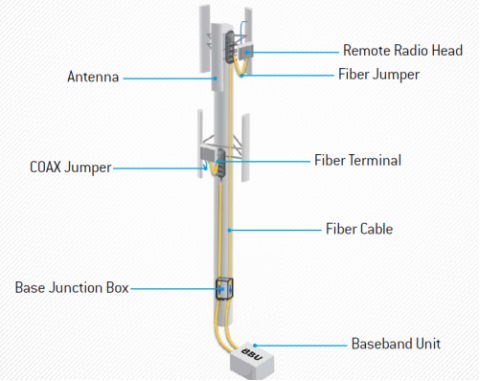
What is the Future of FTTA?
Consumer demand and technological advancement will continue to challenge the broadband infrastructure and necessitate more innovation. As incremental improvements such as active antennas integrated with the RRH to eliminate the need for all coax, small cell technology, and tower construction continues to evolve, it is safe to assume the future of FTTA may hold a few more surprises.
5G network provides speeds up to 100 times faster than 4G, which requires more small cell sites/DAS and improvements in conventional antenna tower bandwidth. Fiber optics will continue to provide the lifeblood to this ever-evolving network because only fiber can support the backhaul of these small cell sites produced by this intense proliferation of traffic.
Conclusion
FTTA is an innovative, flexible, and future-oriented way to install the network. It secures your network connectivity today and in the future.
Sun Telecom specializes in providing one-stop total fiber optic solutions for all fiber optic application industries worldwide. Contact us if you have any needs.
#suntelecom#fiberoptic#telecommunications#fttx#telecomengineering#cabling#osp#fiberopticcable#catv#telecomconsult
2 notes
·
View notes
Text
Tecno has launched the Camon 20 Series in the Kenyan market
Tecno has launched the Camon 20 Series in the Kenyan market, the series includes Camon 20 Premier 5G, Camon 20 Pro 5G, Camon 20 Pro and Camon 20.
The device is powered by a MediaTek Dimensity 8050 Chip which has an advanced 6nm octa-core architecture. With up to 3GHz CPU frequency, performance smooth and lag-free, whether running day-to-day apps or large-scale games. It utilizes, a Triathlon…

View On WordPress
3 notes
·
View notes
Text
5G Core Architecture Explained: What You Need to Know
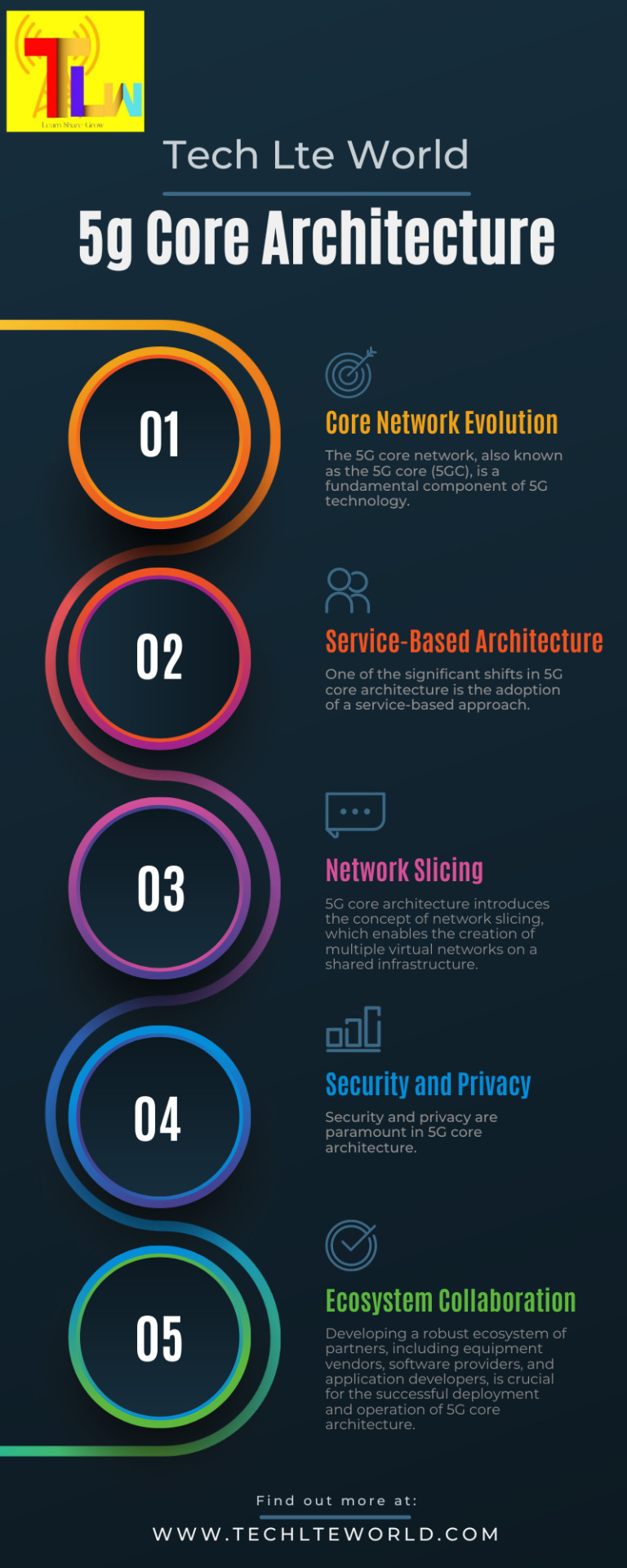
Curious about 5G core architecture? Dive into our easy-to-understand guide! Learn about the main parts and how they work together to power super-fast 5G networks. Stay ahead in the world of technology with our simple explanations.
0 notes
Text
Emerging trends: How to protect your Software Defined Vehicle - CyberTalk
New Post has been published on https://thedigitalinsider.com/emerging-trends-how-to-protect-your-software-defined-vehicle-cybertalk/
Emerging trends: How to protect your Software Defined Vehicle - CyberTalk


Micki Boland is a global cyber security warrior and evangelist with Check Point’s Office of the CTO. Micki has over 20 years in ICT, cyber security, emerging technology, and innovation. Micki’s focus is helping customers, system integrators, and service providers reduce risk through the adoption of emerging cyber security technologies. Micki is an ISC2 CISSP and holds a Master of Science in Technology Commercialization from the University of Texas at Austin, and an MBA with a global security concentration from East Carolina University.
In this highly informative Cyber Talk interview, Check Point expert Micki Boland provides an analysis of Software Defined Vehicles, describing their advantages and flaws, along with actionable security best practices that can keep software safe.
Help our readers understand what benefits the Internet Connected Software Defined Vehicle provides to drivers, automakers and public transportation systems:
For a variety of stakeholders, the continued development of connected vehicles offers several key benefits. I’ll briefly outline them below:
1. Driver’s perspective:
Improved driving experience by optimizing routes.
Enhanced personal safety through real-time information about road hazards, construction zones, and weather-related dangers.
Access to rapid emergency services and roadside assistance on demand.
2. Vehicle manufacturer’s perspective:
Ability to offer road hazard services and monitor vehicle telemetry data.
Delivery of software updates for infotainment and onboard systems.
Monitoring of vehicle health and providing consumers with access to vehicle statistics.
Enhances vehicle safety with features like crash avoidance systems.
3. Public transportation systems and public safety:
Communication with intelligent transportation systems to improve infrastructure.
Integration with smart city infrastructure to enhance public safety and reduce traffic-related fatalities.
Connected vehicles are not just a concept; they are a reality. Many vehicles already transmit telemetry data to auto makers and third parties, allowing for software updates and remote monitoring. Additionally, across the globe, efforts are underway to establish communication between vehicles and traffic management systems, contributing to the development of smart cities.
Is my Software Defined Vehicle vulnerable to hijacking, vehicle theft and the hacking of systems and software? Is it also capable of invading my privacy?
Threat actors are actively seeking to hijack core system functions in order to steal cars. You may have seen recent media reports about two auto manufacturers susceptible to hijacking via the vehicle USB port. This is a TikTok challenge and has resulted in vehicle thefts and crash deaths. One manufacturer is offering financial compensation to owners suffering from vehicle theft.
It does not stop there. Sam Curry, a web application security researcher, published fascinating results in a January 2023 report (here). Sam and team found many automotive vulnerabilities related to everything from the telematic (telemetry) platforms, automotive APIs and infrastructure, including cloud infrastructure and DevOps platforms, customer accounts, and the vehicles themselves. Hackers have breached Tesla infotainment systems and even injected code into vehicle headlights!
Attacking the vehicle has long been the subject of hacker conferences. In real life, hacks range from manipulating the vehicle: unlocking it, engine start/stop, flashing headlights, finding vehicle location by VIN number to track vehicle, hijacking the vehicle owner’s online account, hacking telemetry APIs to stealing data. Additionally, commercial fleet management platforms have been the subject of hacks that exploit vulnerabilities in the web and that exploit vulnerabilities in the APIs hosting these applications.
Hackers inject code into vehicle headlights: https://www.thedrive.com/news/shadetree-hackers-are-stealing-cars-by-injecting-code-into-headlight-wiring
Hackers breached Tesla Infotainment system: https://www.securityweek.com/tesla-hacked-twice-at-pwn2own-exploit-contest/
At present, why aren’t Internet Connected Software Defined Vehicles sufficiently secure?
Securing connected vehicles is a critical concern for the cyber security industry, auto makers and suppliers, third party fleet management providers, 5G network providers, and 5G device makers — all of which are involved in various aspects of the Internet Connected Software Defined Vehicle ecosystem. To tackle this multifaceted challenge, the automotive industry is taking a comprehensive approach, with a focus on cyber security, standards, architecture, communication protocols, and the perspectives of auto manufacturers.
Where are we really when it comes to Software Defined Vehicle cyber security?
1. Cyber security focus:
The U.S. places significant emphasis on Software Defined Vehicle cyber security, with the automotive sector and its partners actively engaged.
Events like the Annual Automotive Cybersecurity Detroit Conference bring together key industry stakeholders, including manufacturers, government bodies, standards organizations, and Tier 1 suppliers.
2. Automotive standards for cyber security for the lifecycle of Software Defined Vehicles:
ISO/SAE provides essential standards for cyber security engineering in road vehicles.
ISO/SAE 21434:2021 offers a comprehensive framework for managing cyber security risks throughout the vehicle lifecycle, from concept to decommissioning.
3. Auto maker perspectives:
Auto manufacturers face complex challenges in ensuring Internet Connected Software Defined Vehicle safety, cyber security, and privacy throughout a vehicle’s lifecycle.
Key considerations include evolving threats, increased connectivity, complex software ecosystems, Over The Air (OTA) updates, telematics, and data privacy.
What are the remaining challenges in this dynamic and complex systems?
1. Evolving threat landscape: To protect people from evolving vehicle threats, we must continually evolve threat prevention initiatives, which can be tough.
2. Increasing connectivity: Extensive vehicle connectivity expands the attack surface, requiring robust security measures at all entry points.
3. Complex software ecosystem: Managing and securing diverse software components in modern vehicles is essential to prevent vulnerabilities and compatibility issues.
4. OTA updates and patch management: Secure delivery and installation of OTA updates necessitate establishing secure channels and ensuring update authenticity and integrity.
5. Software defined vehicles: The concept of Software Defined Vehicles introduces further security considerations in regards to safeguarding software integrity; not only for auto makers, but also for third party providers of infotainment, telemetry, mapping software, etc.
6. Telematics and data privacy: Telematics systems raise privacy concerns, demanding secure data handling and transmission.
7. Collaboration and standards: Industry-wide collaboration and standards are crucial to effectively address Internet Connected Software Defined Vehicle cyber security complexities and challenges.
Addressing these complexities requires continuous investment in cyber security research, rigorous testing, partnerships with experts, and adherence to industry best practices to ensure the safety, security, and privacy of Internet Connected Software Defined Vehicles.
Can you explain Over The Air (OTA) updates for Software Defined Vehicles?
The hallmark feature of a Software Defined Vehicle is the capacity for Over The Air (OTA) updates. OTA updates are essential for keeping the vehicle’s software up-to-date (similar to patch management for computer systems). These updates are facilitated through the vehicle’s Vehicle Identification Number (VIN) and are applicable to both traditional and electric vehicles.
They are delivered in various ways, including through embedded 5G or tethering with the owner’s mobile device. OTA updates encompass infotainment system enhancements, security updates, feature improvements, and system fixes. Communication during OTA transactions involves data exchange between the vehicle, the auto manufacturer, and third parties, and integration with the vehicle owner’s mobile application and customer web portal.
Can you provide some recommendations to help protect my Internet Connected Software Defined Vehicle?
You can take steps to dramatically reduce the risk to your Software Defined Vehicle as it relates to safety, security, and privacy.
1. Protect the mobile devices connecting to your Software Defined Vehicle with a mobile threat prevention tool, like Check Point Harmony Mobile. If you are connecting your mobile device to your Software Defined Vehicle, you need good mobile threat prevention to block malicious applications, smishing, malicious links, and to defend against man-in-the-middle attacks. And be sure to extend mobile threat prevention to any devices connecting to your 5G mobile WiFi hotspot and/or your vehicle’s embedded 5G mobile WiFi hotspot.
2. Conduct a thorough review your security and privacy settings for your Software Defined Vehicle. Typically, this is done from your vehicle’s command center, mobile application, and online vehicle portal. Understand security and privacy settings, as well as the cadence for security and privacy-related software updates. Limit the amount of information that you share with your auto manufacturer and third parties. Again, your VIN is privileged information and so is your vehicle location.
3. Securely manage your vehicle mobile application. Software Defined Vehicles come with a mobile application associated with the car’s VIN, enabling the owner to view vehicle location and system status’, to request roadside service, and to inform maintenance programs of issues.
Review your mobile application settings and privacy warnings. Know that in many instances, the Software Defined Vehicle owner has limited control of the settings regarding what information is to be shared with the auto maker and its designated third parties. From a physical security perspective, never remote start your vehicle with your mobile application unless you have control of your vehicle’s physical security.
4. Manage the internet connectivity to your Software Defined Vehicle. Only you should determine when your vehicle accepts Over the Air updates. Whether you synchronize your 5G mobile device to your Software Defined Vehicle or have onboard embedded 5G, your vehicle will seek to connect when there is an internet connection available. Many vehicles support software updates over all available communications methods: embedded 5G, Bluetooth and WiFi.
Make sure you do allow automatic software and feature updates only when your vehicle is idle.
Note: Not only does your vehicle want to auto-initiate system and security updates, but it also runs third party software that wants to auto-install feature and security updates. These third party software sources all have potential vulnerabilities. In my case of a 2023 Ford F350, there are 30 pieces of open source software on board this vehicle.
5. Use Multifactor authentication on your Software Defined Vehicle online portal. Enough said!
6. Mind the physical security of your Software Defined Vehicle. Park your vehicle in well-lit and secure environments if possible. If you have a vehicle on the “most wanted” list, apply the security fixes, park in a garage or in another secure environment. Always use situational awareness. If your vehicle is one that has vulnerabilities, get the fixes or get a wheel lock put in place. Some of the auto makers are providing these for vehicle owners.
#2023#5G#Accounts#air#Analysis#APIs#Application Security#applications#approach#architecture#authentication#automotive#automotive industry#awareness#bluetooth#board#cadence#Cars#challenge#Check Point#CISSP#cities#Cloud#cloud infrastructure#code#Collaboration#command#communication#communications#comprehensive
0 notes
Text
Best Smartphones to buy under Rs. 20,000 in 2023 (January - February edition)
Hey there,
If you're surfing through the internet in search of a new phone for yourself or to gift someone then, you've come at the right place!
If your budget is under Rs.20k then don't worry, I've got you covered :)
Redmi Note 11 pro
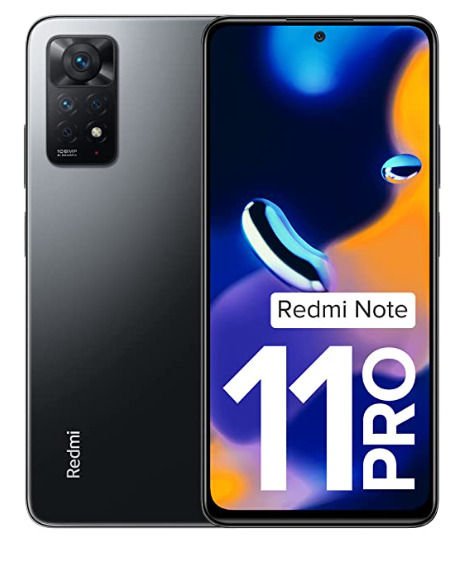
First up we have the Redmi note 11 Pro, this isn't surprising cuz redmi has been releasing really good smartphones lately. It's an absolute value for money at this price!
Key features -
The 6.67" FHD+ 120Hz AMOLED display along with 360Hz touch sampling and 1200 nits peak brightness, brings out immersive picture quality and ensures smoother and faster response. Display is protected by Corning Gorilla Glass 5
The quad camera setup with flagship 108MP HM2 sensor, 8MP Ultra-Wide sensor, 2MP Macro and 2MP depth sensor ensures flawless photography. The 108MP camera delivers images with crystal clear clarity even when zoomed in. The four cameras work together to bring out the best images in all scenarios
The 67W fast charger that comes in the box, powers the massive 5000mAh battery to 50% in less than 15 mins which gives you enough power to last the entire day
The powerful Mediatek Helio G96 SoC ensures excellent gaming and smooth day-to-day performance. The Liquidcool technology ensures that your phone remains cool even while running intensive tasks
The dual stereo speakers setup brings out loud and balanced audio from the device, making the gaming, multimedia experience extremely captivating
Get 2 months of YouTube Premium free!
Cons -
there are barely any cons this phone has but one would be the little bit of bloatware it has left in the MIUI software, other than that this is phone is an absolute beast.
2. Redmi Note 12 5G

Next up we have another redmi phone and, this is the latest offering by redmi. This would've been the best phone in this list if it wasn't overpriced for its specs.
Key features -
Display: Super AMOLED (1080x2400) Display with 120Hz Refresh rate; 1200nits peak brightness; 240Hz Touch sampling rate
Processor: Snapdragon 4 Gen1 6nm Octa-core 5G processor for high performance and efficiency with Adreno 619 GPU; Up to 2.0GHz
Camera: 48MP AI Triple camera setup with 8MP Ultra Wide sensor and 2MP Macro camera| 13MP Front camera
Battery: 5000mAh large battery with 33W fast charger in-box and Type-C connectivity
Memory, Storage & SIM: 4GB RAM | 128GB UFS 2.2 storage expandable up to 1TB | Dual SIM (nano+nano) Dual 5G (5G+5G)
Cons -
There aren't really much cons about this phone other than it's pricing. Overall a great smartphone for it's price.
3.iQOO Z6 Pro 5G

Really good smartphone by iQOO and it'll fulfill every smartphone need of yours without a hiccup. Fast and smooth is the motto of this phone and it lives up to it.
Key features -
Snapdragon 778G comes with octa-core processor that adopts the 6nm process and Kryo 670 architecture.
66W FlashCharge
Liquid Cooling system intelligently sense the heat source and adapt the optimal cooling solution, thereby effectively cool down the phone and reduce the CPU temperature by 12 degrees and surface temperature by 3 degree.
Equipped with 64MP triple camera system, 8MP Wide-angle camera, 2MP Macro camera
iQOO Z6 Pro 5G display provides immersive visual experience with true color contrast and a peak brightness of 1300 nits. HDR10+ helps in providing right color tone mapping for each scene. The display offers 90Hz refersh rate and 180Hz Touch Sampling Rate for a smooth touch response.
Cons -
Y'all maybe wondering why this is below redmi 12 so my answer to that question is - This phone has Mediocre software and the touch sampling rate could've been better. Also the original price of this phone is way above the budget so, if u can catch during the sale right now then you'll get your money's worth.
4. OnePlus Nord CE 2 Lite 5G
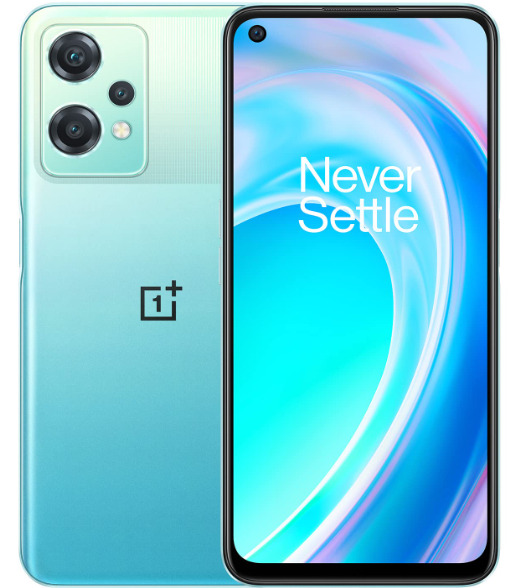
Next up on the list we have the Oneplus Nord CE Lite 2 5G. This phone lives up to its brand's reputation and doesn't disappoint us. It's got all the goodies you'll need in a smartphone in this price segment.
Key Features -
Camera: 64MP Main Camera with EIS; 2MP Depth Lens and 2MP Macro Lens; Front (Selfie) Camera: 16MP Sony IMX471
Camera Features: AI scene enhancement, Dual-View Video, HDR, Night Portrait, Panorama Mode, Retouch Filters, 1080p video at 30 fps, SLO-MO: 720p video at 120 fps, TIME-LAPSE: 1080p video at 30 fps, Video editor, Face unlock, Screen flash, HDR, NIGHT, PORTRAIT, TIME-LAPSE, Retouch, Filters
Display: 6.59 Inches; 120 Hz Refresh Rate; Support sRGB, Display P3; Resolution: 2412 x 1080 pixels 402ppi; Aspect Ratio: 20:9
Display Features: Dark mode
Operating System: Oxygen OS based on Android 12
Processor: Qualcomm Snapdragon 695 5G
Battery & Charging: 5000 mAh with 33W SuperVOOC
Cons -
All though the phone is good, it's battery life isn't as great as it's redmi competitors and another thing which spoils the reputation of this phone is the new OxygenOS 13 which is buggy sometimes and the OG Oneplus fans aren't happy abt this either cuz OxygenOS is turning into RealmeUI.
5. Realme Narzo 50 Pro 5G
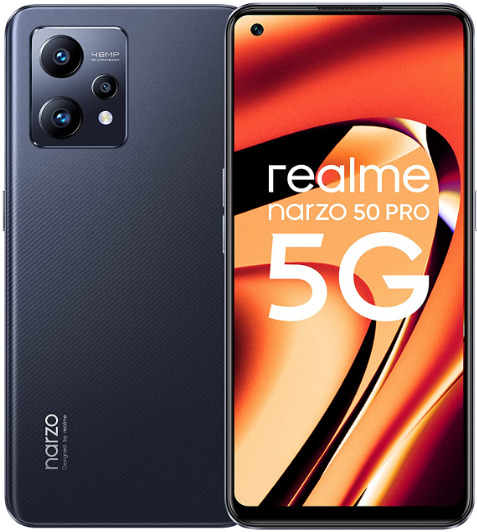
Last up we have the Realme Narzo 50 pro 5G. Overall it's a good package and will get your daily needs done unless you like taking a lot of photos and videos then i wouldn't recommend this phone for that. Its not that it can't take good pics or videos but, it's competitors can take better ones.
Key Features -
Mediatek Dimensity 920 5G powerful Gaming Processor
6 GB RAM | 128 GB ROM | Expandable Upto 256 GB
16.3 cm (6.4 inch) FHD+ Display
48MP + 8MP + 2MP | 16MP Front Camera
5000 mAh Battery
Cons -
Mediocre cameras and display and an average phone overall.
Although most of these are smartphones from 2022, they are still really good! But if you can, wait a few more months so that you can buy the new releases from these brands. With that we come to the end of this list and I hope y'all found this helpful.
3 notes
·
View notes
Text
Virtual Library Opens Inside Minecraft To Share Banned News Stories
Reporters Without Borders has found an entirely new way of distributing banned journalism from some of the world's most repressive countries: Minecraft.
The advocacy group has launched a new virtual space on a dedicated server for the game of video that is popularly known as "The Uncensored Library," accessible to any of Minecraft's 145 million monthly users.
The library will feature news stories that were censored in the country of their origin that are influenced by the neoclassical architectures of the past of Rome and Greece.
The Uncensored Library is a new virtual library in Minecraft, created in part by Reporters Without Borders to host the work of journalists that are banned or censored in their home countries
The library will feature stories from five countries which are near the bottom of Reporters Without Borders’ World Press Freedom Index. Balonium.com These include Egypt, Russia, Saudi Arabia and Vietnam.
The stories will be published in English as well as in the original language they were written in.
The text of the stories can't be edited or altered however anyone who has access to the Minecraft server hosting the library can read the stories.
EE focuses 5G rollout in areas where there are a lot of people. Scientist who claims coronavirus came from SPACE by meteor... Lloyds and Halifax banking apps go down leaving customers... Uber may suspend accounts of users and drivers if they test...
34k shares
The project is backed by a number of prominent journalists who have had their work or that of someone they loved removed from publication. They include Nguyen Van Dai, a Vietnamese blogger, Yulia Berezovskaia, and Hatice Cengiz, who was the fiancee of Jamal Khashoggi, the murdered journalist.
Christian Mihr, Reporters Without Borders Christian Mihr, Reporters Without Borders, said that "In many countries around world there isn't a free access to information," in a statement posted on the group's website.
Websites are blocked, independent news outlets are banned, and the press is controlled by the state. Young people are unable form their own opinions as they get older.
By using Minecraft the world's most played computer game as an instrument, we grant players access to information from independent sources.'
To start with, the library will feature the work of journalists that are banned in five countries, including Egypt, Vietnam, Russia, Saudi Arabia, and Mexico
The library was built by 16 people using more than 125 million blocks. They were inspired by the neoclassical architecture of ancient Rome and Greece
The library is currently supported by prominent journalists from around the world such as Vietnamese blogger Nguyen Van Dai, Russian journalist Yulia Berezovskaia, and Hatice Cengiz, who was fiancee the murdered journalist Jamal Khashoggi.
Reporters Without Borders joined forces with DDB German, BlockWorks design studio, and Media Monks production company to create The Uncensored Library
The stories will be available in both English and the language they were originally published in, and the readers cannot alter or edit the text in any way
The virtual opening of the library coincided with World Day Against Cyber Censorship. This annual observance was initiated in 2008 by Reporters Without Borders and Amnesty International.
The Library was built by 24 'builders' from 16 countries, using the equivalent of 125 million blocks. It features a large central rotunda that measures 984 feet wide.
The project was the result of a partnership between Reporters Without Borders, the creative agency DDB German, design studio BlockWorks and the production company Media Monks.
3 notes
·
View notes
Text
MediaTek Flagship SOC Dimensity 9200
MediaTek has announced the latest innovation of its Dimensity flagship chipsets, with the Dimensity 9200 positioned to compete with the Snapdragon 8 Gen 2 and appear in smartphones before the end of the year.
It's a second-gen 4nm chip powered by the latest generation of Armv9 architecture, including ray-racing from the Immortalis-G715 GPU, along with next-gen features like support for 240Hz displays and Wi-Fi 7. With integrated mmWave 5G, it's Also the first Dimensity flagship that's positioned well to break into the US market – though that'll still take some doing.Here's everything you need to know about the Dimensity 9200.MediaTek has lifted the lid on the Dimensity 9200, the company's latest 5G chipset. Billed as being designed to power 'the next era of flagship smartphones, the Dimensity 9200 is the world's first smartphone SoC equipped with an ARM Cortex X3 CPU core. Similarly, the Dimensity 9200 debuts ARM's Immortalis-G715, a GPU that supports hardware-based ray tracing, as well as Wi-Fi 7 Ready connectivity.Additionally, MediaTek claims numerous other firsts for the Dimensity 9200 too, such as LPDDR5X RAM running at 8533 Mbps and an RGBW ISP. Moreover, the Dimensity 9200 relies on TSMC's second-generation 4 nm manufacturing process (N4P), along with ARM's second-generation Armv9 architecture. For reference, MediaTek has built the Dimensity 9200 with the following CPU cores:
1x Cortex-X3 - 3.05 GHz
3x Cortex-A715 - 2.85 GHz
4x Cortex-A510 - 1.8 GHz
Purportedly, MediaTek's new chipset delivers 12% better single-core performance in Geekbench 5.0 than the Dimensity 9000.However, the gap narrows to 10% in multi-core work.With that being said, the Dimensity 9200 offers 25% lower power consumption under load, 10% better heat dissipation capabilities and up to 32% improved GPU performance in Manhattan 3.0 when compared to the Dimensity 9000 while utilizing 41% less power to boot.
All in all, MediaTek boasts that the Dimensity 9200 scores 1,260,000 points in AnTuTu v9, which would be significantly higher than any current flagship scores. Currently, MediaTek has only revealed that the Dimensity 9200 should reach shelves 'by the end of 2022'. Unfortunately, it remains to be seen in what smartphones the Dimensity 9200 will feature, nor how it compares to the upcoming Snapdragon 8 Gen 2.
2 notes
·
View notes
Text
5G Core Protocol and Procedures | 5G Call Flow | 5G Network | 5G Core | SBA
This is recording of open session where we discussed about 5G Core Protocol and Procedures & 5G Call Flow.
You can check complete video in the link given below - 5G Core Protocol and Procedures | 5G Call Flow - https://youtu.be/9w8hFEykB8M
2 notes
·
View notes